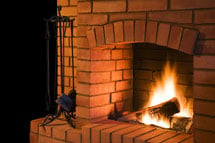 As the temperatures drop and colder seasons approach, many enjoy sitting by a cozy fire with their family and friends. There’s nothing like a toasty fire on a snowy winter night.
As the temperatures drop and colder seasons approach, many enjoy sitting by a cozy fire with their family and friends. There’s nothing like a toasty fire on a snowy winter night.
Before the snow flies, however, ensuring your chimney is clean and ready for those fall and winter fires is vital.
If your fireplace is wood-burning, you should be careful of creosote buildup. Creosote is a residue that travels up your chimney and builds up on your flue over time. In fact, some creosote builds up every time a wood-burning fireplace is lit. If that residue isn’t properly cleaned out, the chance of a fire igniting in your chimney increases. Many consider a creosote fire in the chimney one of the most dangerous fires a homeowner can experience; it can spread quickly and severely damage or destroy your entire home within minutes.
Here is some information you need to know about wood-burning fires.
1. Wood type. You can burn hard or softwood as long as it’s seasoned. Seasoned wood is wood that’s cut, especially oak (hardwood), and sits idle in a dry environment for an entire year. Damp wood not seasoned for over a year creates cooler, smoldering fires and isn’t worth burning. Properly-seasoned wood makes hot fires that produce less creosote, so there’s less buildup on your flue and in your chimney.Do you know what seasoned wood looks like? Seasoned wood is dark or grey on the outside and white on the inside. The bark on the wood will also have a flaky appearance. The best seasoned wood is two-three years old.
If you’re not experienced at building fires in your home’s fireplace or only burn a few fires a year, a seasoned softwood like fir may be the way to go. It seasons quickly and makes nice large flames when it burns. The downside to fir – or any other softwood -- is that it doesn’t burn as long as hardwoods like oak and walnut.





